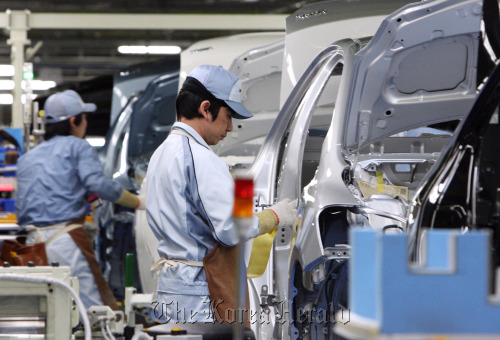Quake halts assembly lines and work at suppliers including paint pigment maker
Global automakers may lose production of 600,000 vehicles by the end of the month as the earthquake in Japan halts assembly lines and work at suppliers including the maker of a paint pigment.
About 320,000 vehicles may have been lost worldwide as of March 24, and manufacturing at plants in North America may be affected when parts supplies start running out as soon as early April, said Michael Robinet, vice president of Lexington, Massachusetts-based IHS Automotive.
“The next surge of shutdowns comes when the pipeline of parts that were already built dries up,” Robinet said Friday in a telephone interview. “The rate of lost production will accelerate once North American plants join in.”
Toyota Motor Corp., the world’s largest automaker, said it has lost output of 140,000 vehicles, and Honda Motor Co. has lost 46,600 cars and trucks and 5,000 motorcycles. Mitsubishi Motors Corp.’s was lowered by 15,000. Ford Motor Co. hasn’t lost any output, said Todd Nissen, a spokesman.
Honda, Japan’s third-largest automaker, said its production in North America may be disrupted after April 1 because quake damage is restricting parts supplies, Natsuno Asanuma, a spokeswoman for the company, said Saturday by phone. Plants in Ohio, Alabama, Indiana, Canada and Mexico may be affected, she said.
Mazda Motor Corp., which had said its production was reduced by 31,000 cars, Friday suspended U.S. dealer orders for vehicles built at its two Japanese car factories because of supply disruptions caused by this month’s earthquake and tsunami.
Mazda plants in Hiroshima and Hofu have stopped production of new models, said Tim Gilman, a spokesman. Mazda makes the Mazda2, Mazda3, RX-8, MX-5, CX-7 and CX-9 in Japan, he said. While neither plant was damaged, access to parts and supplies has been crimped in the aftermath of the disaster, he said Nissan Motor Co., General Motors Co. and other companies haven’t provided details on their possible losses.
 |
Workers assemble a Toyota Motor Corp. vehicle on the production line of Central Motor Co.’s Miyagi plant in Ohira Village, Miyagi Prefecture, Japan. (Bloomberg) |
Merck KGaA has lost production of a metallic automotive paint pigment called Xirallic because its factory is 45 kilometers from the Fukushima Daiichi plant that was damaged by the earthquake and tsunami, Gangolf Schrimpf, a spokesman for the Darmstadt, Germany-based company, said in a telephone interview.
Merck doesn’t know when company engineers will be able re-enter the Onahama factory, and it will take four to eight weeks to resume output after they gain access, he said.
“It’s not our fault, and we can’t get back in,” Schrimpf said. “It’s bad for us and bad for our customers. It’s sort of at a dead-end currently.”
The company isn’t affiliated with Merck & Co., the drugmaker based in Whitehouse Station, New Jersey.
Chrysler is restricting dealers’ orders on 10 vehicle colors because of the potential for a shortage, Katie Hepler, a spokeswoman, said Friday in an e-mail. The colors include blacks, such as Blackberry Pearl, and reds, such as Inferno, she said.
“We currently have an adequate days’ supply to meet existing customer orders and are taking this step as a precautionary measure,” Hepler said.
Ford told dealers March 24 to stop taking orders for vehicles painted in tuxedo black and three red shades.
Silver was the most popular automobile color last year, Pittsburgh-based PPG Industries Inc., the largest supplier of paint for North American auto production, said in October. Silver, gray and charcoal accounted for 31 percent of vehicle-paint choices in North America, up from 20 percent in 2008. Black and white tied for second, with 18 percent each. Red was next at 11 percent, said PPG, which makes auto paint.
“We could certainly see some slowdown in sales,” said Rebecca Lindland, an analyst for IHS Automotive. “Black and red cars are pretty darn popular.”
DuPont Co., the second-largest auto-paint supplier in North America, is monitoring the situation and the potential impact to its customers, Gregg Schmidt, a spokesman, said in an e-mailed statement. The Wilmington, Delaware-based company does use Xirallic, Schmidt said.
Mike Millar, a spokesman for PPG, declined to comment.
GM idled two compact-car plants in Europe and a pickup factory in Shreveport, Louisiana, amid parts shortages. GM sent electronics parts from Shreveport to a factory in Kansas City, Kansas, where the more-profitable Chevrolet Malibu and Buick LaCrosse sedans are made, said two people familiar with the matter.
Production in Shreveport will resume on March 28, Sherrie Childers Arb, a GM spokeswoman, said Friday in an interview.
GM executives sent out a memo on March 18 asking employees to limit travel and expenses to essential business. The move was a precaution, she said.
U.S. automakers’ plants may experience sporadic shutdowns because they get so many parts from Japan, said Brian Johnson, an analyst with Barclays Capital in Chicago. While lost production would hurt earnings, lower inventory among the Japanese automakers may allow GM, Ford and Chrysler Group LLC to gain market share or reduce price discounts, he said. (Bloomberg)
Earnings estimates
Johnson hasn’t adjusted his earnings estimates for Ford or GM and maintains projections that GM’s shares may rise to $44 and Ford’s may gain to $22 by December. The targets haven’t been changed because they are based on 2012 earnings, which shouldn’t be affected by the crisis in Japan, he said.
Automakers who buy certain parts from one manufacturer may start to look to diversify their supply bases with different companies or with plants in multiple regions, Johnson said. (Bloomberg)








